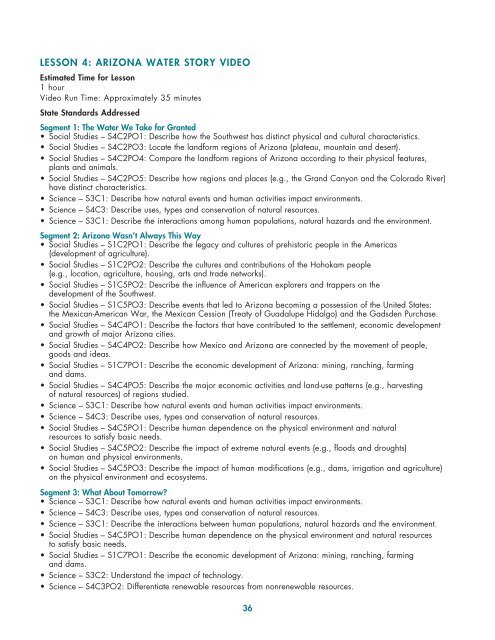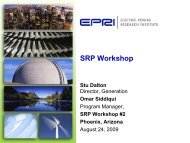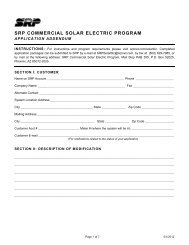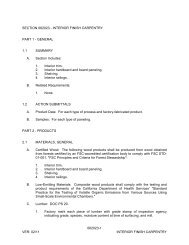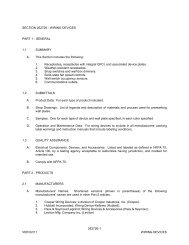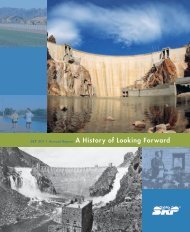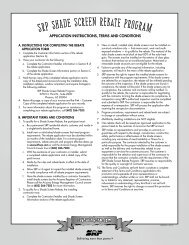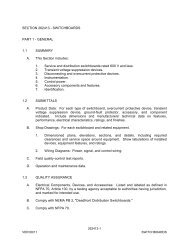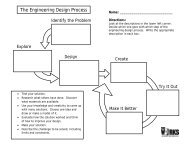LESSON 4: ARIZONA WATER STORY VIDEO - Salt River Project
LESSON 4: ARIZONA WATER STORY VIDEO - Salt River Project
LESSON 4: ARIZONA WATER STORY VIDEO - Salt River Project
- No tags were found...
Create successful ePaper yourself
Turn your PDF publications into a flip-book with our unique Google optimized e-Paper software.
<strong>LESSON</strong> 4: <strong>ARIZONA</strong> <strong>WATER</strong> <strong>STORY</strong> <strong>VIDEO</strong>Estimated Time for Lesson1 hourVideo Run Time: Approximately 35 minutesState Standards AddressedSegment 1: The Water We Take for Granted• Social Studies – S4C2PO1: Describe how the Southwest has distinct physical and cultural characteristics.• Social Studies – S4C2PO3: Locate the landform regions of Arizona (plateau, mountain and desert).• Social Studies – S4C2PO4: Compare the landform regions of Arizona according to their physical features,plants and animals.• Social Studies – S4C2PO5: Describe how regions and places (e.g., the Grand Canyon and the Colorado <strong>River</strong>)have distinct characteristics.• Science – S3C1: Describe how natural events and human activities impact environments.• Science – S4C3: Describe uses, types and conservation of natural resources.• Science – S3C1: Describe the interactions among human populations, natural hazards and the environment.Segment 2: Arizona Wasn’t Always This Way• Social Studies – S1C2PO1: Describe the legacy and cultures of prehistoric people in the Americas(development of agriculture).• Social Studies – S1C2PO2: Describe the cultures and contributions of the Hohokam people(e.g., location, agriculture, housing, arts and trade networks).• Social Studies – S1C5PO2: Describe the influence of American explorers and trappers on thedevelopment of the Southwest.• Social Studies – S1C5PO3: Describe events that led to Arizona becoming a possession of the United States:the Mexican-American War, the Mexican Cession (Treaty of Guadalupe Hidalgo) and the Gadsden Purchase.• Social Studies – S4C4PO1: Describe the factors that have contributed to the settlement, economic developmentand growth of major Arizona cities.• Social Studies – S4C4PO2: Describe how Mexico and Arizona are connected by the movement of people,goods and ideas.• Social Studies – S1C7PO1: Describe the economic development of Arizona: mining, ranching, farmingand dams.• Social Studies – S4C4PO5: Describe the major economic activities and land-use patterns (e.g., harvestingof natural resources) of regions studied.• Science – S3C1: Describe how natural events and human activities impact environments.• Science – S4C3: Describe uses, types and conservation of natural resources.• Social Studies – S4C5PO1: Describe human dependence on the physical environment and naturalresources to satisfy basic needs.• Social Studies – S4C5PO2: Describe the impact of extreme natural events (e.g., floods and droughts)on human and physical environments.• Social Studies – S4C5PO3: Describe the impact of human modifications (e.g., dams, irrigation and agriculture)on the physical environment and ecosystems.Segment 3: What About Tomorrow?• Science – S3C1: Describe how natural events and human activities impact environments.• Science – S4C3: Describe uses, types and conservation of natural resources.• Science – S3C1: Describe the interactions between human populations, natural hazards and the environment.• Social Studies – S4C5PO1: Describe human dependence on the physical environment and natural resourcesto satisfy basic needs.• Social Studies – S1C7PO1: Describe the economic development of Arizona: mining, ranching, farmingand dams.• Science – S3C2: Understand the impact of technology.• Science – S4C3PO2: Differentiate renewable resources from nonrenewable resources.36
• Arizona WaterStory videoObjectivesMaterials• Segment handouts(1 per student) It isrecommended thatyou blow up thehandouts to 11-by-17 inches. This willallow more roomfor students to write,and handouts canalso be made into a large brochure of factsabout Arizona. Allow students to illustratethe other faces of the brochure.ProceduresPass out the video guide to students. Read throughthe questions with the class before watching thevideo. You may want to pause the video periodicallyto allow students time to discuss and record theiranswers to the questions. At the end of each segment,review the questions with the students to reinforcetheir learning. To allow ample time for discussion,it is recommended that the segments be viewed onseparate days.Segment 1: The Water We Take for Granted(run time: approx. 11 minutes)Segment 2: Arizona Wasn’t Always This Way(run time: approx. 13 minutes)Segment 3: What About Tomorrow?(run time: approx. 11 minutes)Content Objectives• Students will be able to describe the contributionsof past people (Hohokam, American explorers,Mexican-Americans) on settlement and developmentof the land we now call Arizona.• Students will be able to describe the process inwhich water is delivered to the Desert Regionof Arizona.Language ObjectiveStudents will use complete sentences to describe howwater plays a part in the history of Arizona.VocabularyDesert: a land area that receives less than 10 inchesof rain in a yearDrought: a long period of abnormally lower rainfallthat creates a shortage of waterErosion: how the earth is worn away by water,glaciers, wind and wavesFloods: when large amounts of water overflow thebanks of rivers and streamsGroundwater: water that is pumped from deepunderground, in between the rocks and sandPlateau: a large area of high and fairly flat landPrehistoric: the time before there were any written recordsSurface water: water that flows over the surface of the landReservoir: a large natural or artificial lake used to storewater until it’s ready to be usedRenewable energy: energy produced with a sourcethat is created over and over again by natureWatershed: a land area that drains into a body of water37EvaluationHave students complete the video guide worksheets, anddiscuss the answers as a class (answers canbe found in the Appendix).Lesson ClosureAs a conclusion to thelesson, have the studentsdiscuss the followingitems in pairs:• Explain why andhow we are ableto have waterin the DesertRegion ofArizona.• Explain where weget our waterfrom in (your town).ArizonaFacts
Arizona Water Story Video ScriptIntroductionArizona is a land of natural wonders, from the Grand Canyon carved by the mighty Colorado <strong>River</strong>, to the delicateand dry colors of the Painted Desert, to the dense, green forests of the White Mountains. But we tend to forget thatmuch of the Arizona we know today, with its growing cities and productive farms, was once a dry and desolatewilderness. What changed the landscape? The availability of water. Water has shaped Arizona’s history as wellas its landscape.Segment 1: The Water We Take for GrantedCathy: Whew! That really hit the spot. But before I tell you what this glass of water has to do with why you’re here,I’d like you to meet some of my friends.Alex: Hi. My name is Alex.Johnna: And I’m Johnna.Taylor: I’m Taylor. This water is for my dog, Boxer.Zoe: My name is Zoe, and I want my water good and cold when I’m ready for a drink.Cathy: Here’s one more friend. Meet Gilbert Gecko. It’ll be his job to help us tell the story of water in Arizona.Cathy: Now you all live here in Arizona, and what you have in common is that your grandparents and greatgrandparentsand great-great-grandparents played a role in making Arizona what it is today. They had a part inmaking sure you have all the water you need, when you need it. And Gilbert? He’s from Arizona, too.Cathy: Now here’s a question for you. How many ways in a single day do you expect water to be there for you?Taylor: Well, I wake up every morning and take a shower.Alex: I have to brush my teeth twice a day.Johnna: And I have to wash dishes after breakfast every morning.Zoe: One of my jobs is to water the garden outside.Cathy: Without this water, we’d be up a creek without a paddle, right?Alex: Wait a minute. Without water, there wouldn’t even be a creek.Cathy: You’re so right. And perhaps a creek is a good place for us to begin our story.Cathy: First, remember that Arizona is located in the Southwestern part of the United States, along with California,Nevada, Utah, Colorado and New Mexico. And right in the middle of these states is a mighty river. Anyone knowits name?Johnna: Of course we do.Kids together: It’s the Colorado <strong>River</strong>.Cathy: That’s right. In fact, did you know that a raindrop that falls in Wyoming or Nevada could end upbeing drinking water for someone in Tucson?Johnna: So, this glass might actually have water in it from some place in Wyoming?Alex: And my glass could have water from Las Vegas?Zoe: That’s really neat.Cathy: It is. All of these states are connected because we’re all part of the Colorado <strong>River</strong> Watershed and becausewater is delivered from the Colorado <strong>River</strong> to some of our cities. In fact, all of the rivers in Arizona eventually draininto the Colorado <strong>River</strong>. These rivers are called tributaries.Taylor: Does that include the <strong>Salt</strong> <strong>River</strong> and the Verde <strong>River</strong>?Cathy: Yes. They’re both tributaries of the Gila <strong>River</strong>, which is a tributary of the Colorado.Alex: What about all the other rivers in Arizona?Cathy: Good question. The Santa Cruz and San Pedro rivers are tributaries of the Gila <strong>River</strong>, too. And the Gilaflows to the Colorado.Zoe: So what you’re saying is that finally all the rivers in Arizona are interconnected.Cathy: And it all started with a creek.Alex: Like Christopher Creek near Payson, where I go with my family ever year. Arizona sure has some beautifulplaces, doesn’t it?38
Zoe: They used rocks and brush to build little dams so they could divert the water from the <strong>Salt</strong> <strong>River</strong>, forcing it toflow into the canals.Cathy: Some of the famers formed private canal companies or associations. The men either worked on the canalsand dams themselves or paid a fee for someone else to maintain them. The farmers also hired “zanjeros” to deliverwater through the canal to their farms.Alex: That is an amazing story. Just to think that all the canals near my house might go all the way back to Jack Swilling.Cathy: And that’s just around Phoenix. The people in the Santa Cruz Valley, where Tucson is now, faced similarwater problems.Taylor: Wasn’t Tucson in Mexico at one time?Johnna: I’ve been studying this for a report in school. I searched on my parents’ computer about how Tucson cameto be. It was the first place in Arizona settled by Spanish missionaries and soldiers. Those early settlers farmedand took care of their sheep and cattle.Cathy: You may not have heard about the Treaty of Guadalupe Hidalgo, in 1848. That treaty ended the war.Mexico thought they had the territory, but that was only because someone made a huge mistake and said that theborder between Mexico and the U.S. was on the Gila <strong>River</strong>, 80 miles north of Tucson.Taylor: James Gadsden!Alex: Who is James Gadsden?Johnna: He’s the guy – he must have had tons of money – well, he purchased all that land south of the Gila <strong>River</strong>for the United States gover nment, and it was then that Tucson finally became part of the U.S. It was called theGadsden Purchase.Cathy: In those days, most of Arizona’s population lived in the central part of the state, around Phoenix and Tucson.Not many people lived in other parts of the state. By then, Tucson was becoming a city. But that didn’t solvetheir water problem. Just like Phoenix, they still had to figure out how they could have a reliable source ofwater they needed for their farms and their lives.Alex: It must have been tough being a farmer and living in the desert in those days.Cathy: That’s true. In the late 1800s, they faced the same problems that the ancient Indians had.Johnna: Floods and drought.Cathy: Gilbert, come and help us. We should be clear what we mean when we talk about floods and drought.Alex: Floods: when large amounts of water overflow the banks of rivers and streams.Johnna: Drought: a long period of abnormally lower rainfall that creates a shortage of water.Zoe: In a year with heavy rain and snow in the mountains, the rivers were full of water so that farmers had morethan enough water for their crops. Sometimes all that water washed away the small rock-and-brush dams in the river.Taylor: But in the next year, they might have very little rain and not enough water.Cathy: You’re right; trying to be a farmer under those circumstances, or even trying to provide enough water fordrinking, bathing and cleaning, was very difficult. And to make matters even more complicated, the population ofMaricopa County grew by nearly 10,000 people. People just kept on moving to Arizona. All those people fromthe East and Midwest were looking for a warmer climate or the opportunity to start over in a different part of thecountry or because they heard it would be better for their health. All of those people needed water, too.Johnna: It would have been a real challenge for them to make sure that they could have enough water they could count on.Zoe: You said that one thing the Indians did was build diversion dams so they could control the distribution ofwater. They still did not have a way to collect and store the water running off the mountains.Taylor: So, why couldn’t those farmers just build a bigger dam that could hold even more water from the winterstorms, and then let it flow into rivers and canals when the people needed it?Cathy: They thought of that, too. In the 1890s, a private company was formed to construct what they called a“water storage dam,” or reservoir. A reservoir is a large artificial or natural lake used to store water until it’s readyto be used. But the people could never raise enough money to build the dam.Alex: Don’t you wonder why they just didn’t give up?Johnna: I would guess they almost did. But the more I learn how these people were determined to stick with it, themore I understand that quitting wasn’t something they could ever do.Cathy: That all changed in 1901, after Theodore Roosevelt became president of the United States. Now, who’sbeen learning about him?Zoe: I have.42
Johnna: OK, Mr. President. Tell us how this all happened.Zoe: When I became president, I had the chance to look out at the whole country, especially out West. And Irealized something had to be done so that growing towns and cities would have enough water. I urged Congress topass the National Reclamation Act, which they did in 1902. That act provided for government loans to actuallyreclaim the West with irrigation projects. There were several big projects that started throughout the UnitedStates. One, as you may know, was Hoover Dam on the Colorado <strong>River</strong>, and people started talking about howto deliver Colorado <strong>River</strong> water so that the seven states could share the river. But even before Hoover Dam,was the construction of a huge dam – named after me – Theodore Roosevelt Dam.Cathy: That happened because farmers and landowners in that territory, the ones who wouldn’t give up, formedan association called the <strong>Salt</strong> <strong>River</strong> Valley Water Users’ Association, so they could pledge their land in orderto get a government loan. Now we call the group SRP. After that, things really got going.Taylor: The government hired stonemasons to cut huge blocks of stone out of the nearby mountains to build the dam.Johnna: The equipment and supplies they needed were hauled by mule-driven wagons on the Apache Trail.Cathy: The trail itself was built by Apache and other Native American workers. It’s a trail that connected the endof the railroad near Mesa to the Theodore Roosevelt Dam site.Alex: You know, if it weren’t for the Hohokam and the Apache, we might not even be here now.Zoe: Yes, and though those workers faced many challenges – hot summers, cold winters and a flood in 1905 thatalmost destroyed their work – they didn’t give up, and the dam was finally completed in 1911. I was so happy,that I attended the dedication celebration myself. In fact, there is a photo of me standing on the dam with all thepeople who helped make it happen.Zoe: The building of the dam gave new hope to the people who lived near it. The <strong>Salt</strong> <strong>River</strong> Valley Water Users’Association and the federal government worked together to widen the old canals and build new ones. They alsobuilt ditches – we call them laterals now. They delivered water from the canals to the farmers’ fields and orchards.Alex: That’s how they operated. Workers would open the canals by using hand cranks.Taylor: Those workers were called “zanjeros.”Alex: Hey, I remember you using that word before.Taylor: Yeah, it comes from the Spanish word for ditches: zanjo.Zoe: The zanjeros kept track of how much water the farmers used, and then the farmers were charged for the water.Johnna: For 50 years, teams of horses were used to clean the canals to keep them free from moss and weeds.Now SRP and CAP use algae-eating fish to keep their canals clean.Cathy: You know how you often see joggers on the banks of the canals now? Well in those early days, thanks tothe trees lining them, the banks of the canals were also a place people came for a relaxing stroll or a family picnic.Alex: OK. But that was then. What about now?Cathy: Now there are several dams on the Verde and <strong>Salt</strong> rivers. And one on the Aqua Fria. Two canal systems,operated by SRP and CAP, deliver water from these reservoirs to our homes.Taylor: And one of the canals is practically next door to our house.Zoe: We know that the dams and rivers and canals tell us a lot about how water gets delivered to us today.Cathy: And it all got started years and years ago with the Hohokam.Alex: We lived for many years in what you now call Arizona.Johnna: We dug ditches …Taylor: ... so we could divert the water from rivers and streams …Zoe: … to grow our food.Johnna: I was lucky, I guess. I was exploring and prospecting for gold when I first arrived here. I found some ofthose ancient canals. As more and more people moved West needing more and more water to live on, we figuredout how to rebuild some of those canals and connect them to the rivers. We even built some of the first dams.Zoe: I’m glad I was the president at the beginning of the 20th century. I was able to help the Western part of thecountry grow, thanks partly to Theodore Roosevelt Dam, so we could store water in the reservoir behind the damand then release it into the <strong>Salt</strong> <strong>River</strong> and then into the canals around Phoenix.Cathy: That’s the then, which takes us to the now – to today and the story of how we have built dams to store water andcanals to deliver it to cities and how without CAP – the Central Arizona <strong>Project</strong> – life in southern Arizona would bemuch different than it is now. That story will tell us how when we turn on a faucet, we will have water.Taylor: And how we still can’t take water for granted.43
Segment 3: What About Tomorrow?Johnna: I love being here at the lake with my friends.Taylor: Isn’t it amazing though to think that the water we’re swimming in will actually become the water that wedrink? But how does this water get to our houses?Alex: And once we drink it, is it all gone? To make sure we have enough to drink, how do we get more water intothe reservoir?Zoe: Wouldn’t it be neat if we could recycle water like we recycle bottles and cans?Johnna: I’ve heard about something like that.Cathy: Have you also heard about scientists who are trying out technology that would make it possible to clean thesalt out of ocean water so we can use it, too?Taylor: Wow. So, I guess the really important question is, how do we make sure that there will be water here forthe future so that kids can come and swim in the lake and have plenty of water to drink?Zoe: Yeah, what about tomorrow?Cathy: What about tomorrow? To answer that question, we need to understand how reliable water is deliveredto our homes and businesses now. It’s a story that began with building dams and canals. Remember when wetalked about the geography of Arizona? Most of the rainfall in Arizona happens in the Mountain Region. And weare a part of a larger watershed, the Colorado <strong>River</strong> Basin. As water travels down the mountainous watershedsinto rivers, we can use surface water. However, we need to store it so that we can use it when we need it.Alex: That’s why we need dams.Cathy: You got that right. Let’s go back to 1911.Johnna: That’s when Theodore Roosevelt Dam was completed.Taylor: And that made it possible for the water in eastern Arizona’s mountains and rivers to flow into thereservoir behind the dam, creating Theodore Roosevelt Lake.Cathy: Theodore Roosevelt Lake is the largest reservoir in Arizona, but …Alex: Let me guess – it’s not enough water.Cathy: Well, let‘s do some math. Theodore Roosevelt Lake can store more than 1 million acre-feet of water.Johnna: Good grief. How much is that, and what’s an acre-foot?Alex: I’ll bet Gilbert knows!Alex: An acre-foot is around 326,000 gallons of water.Taylor: And that’s just about how much water it takes to flood a football field to the depth of 1 foot.Zoe: And that’s about how much water two families use in a year.Johnna: Wow. So, that means between our four families, we use nearly 652,000 gallons a year!Zoe: No wonder that’s not enough water for the people in central Arizona. So, what did they do?Taylor: I bet they had to build more dams.Cathy: Locally, people saw that there was a need to build more reservoirs for water supply in the Valley. Inthe 1920s, SRP developed a plan to construct additional dams on the <strong>Salt</strong> <strong>River</strong>.Zoe: Let’s see. On the <strong>Salt</strong> <strong>River</strong>, that includes Mormon Flat Dam, Horse Mesa Dam and Stewart Mountain Dam.Johnna: And the dams and reservoirs on the Verde <strong>River</strong> include Bartlett Dam and Bartlett Lake as well asHorseshoe Dam and Horseshoe Lake.Taylor: Are dams only used for storing water?Cathy: No. These dams also had hydropower capabilities for generating electricity. Water falling through a damcan spin a turbine, which spins a generator.Alex: This generates electricity.Johnna: We learned about electricity in our class this year. We learned that using water to make energy is a cleanway to make energy, so it’s called renewable energy.Taylor: Renewable energy is energy produced with a source that is created over and over again by nature. So thatmeans water is recycled over and over again by nature.Alex: Yeah. Through the water cycle.44
Taylor: Now I get it.Cathy: So SRP and CAP use water flowing through dams to create electricity for homes, farms and businesses.What else can we use these lakes for?Alex: We love to go fishing.Johnna: Boating.Taylor: Bird watching. We almost always see the great blue heron at Saguaro Lake.Zoe: And eagles, too.Cathy: The reservoirs have a lot of different uses: storing water, providing renewable energy and recreation. Butthat’s only part of the delivery equation.Alex: You mean it’s still not enough water?Cathy: No, not necessarily. But remember, part of the problem during both prehistoric and historic times was thatthe water supply wasn’t reliable. Early citizens of Arizona knew they needed to be careful with their water supplyto make sure there was a wide variety of sources of water for Arizonans to use.Johnna: So they began to build canals. Canals brought surface water to treatment plants and eventually to homes.Cathy: Right! We’ll talk more about that later. Let me tell you the story of a very important canal that was built.Taylor: You mean the Central Arizona <strong>Project</strong>.Cathy: Right! The CAP. Statewide, people began discussing how to bring Arizona’s portion of the Colorado <strong>River</strong>water to cities that needed it in southern Arizona. Remember how we started our conversation talking about theColorado <strong>River</strong>? Seven states share that river, and in Arizona, we pump it to central and southern Arizona so itcan be used where there is very little rainfall and lots of people. The Central Arizona <strong>Project</strong>, or CAP, took 20years to construct and was completed in 1993.Alex: The other day in school, we looked at a map of what the CAP looks like.Johnna: The canal begins on Bill Williams <strong>River</strong> near Lake Havasu. This is very close to the Arizona-California border.Taylor: And get this: The canal is 335 miles long, running east and then south, ending just below Tucson.Cathy: In fact, the CAP is the largest river in Arizona, although a man-made one, and provides more than1.5 million acre-feet of Colorado <strong>River</strong> water each year to Maricopa, Pima and Pinal counties.Alex: Are there dams along the CAP route?Taylor: We were just near one last weekend. We were on our boat on Lake Pleasant. That’s the water storagereservoir on the Aqua Fria <strong>River</strong> behind the New Waddell Dam. It’s a 15½-square-mile lake.Cathy: Yes, CAP uses the dams to store water and make renewable energy. CAP pumps water into Lake Pleasantduring the spring and releases water in the summer, when it is hotter and people use more water. Because of this,each year the elevation of the lake might change by 75 feet as water is stored and then used depending on thetime of year. CAP uses the renewable energy from the dams and other sources to power their pumps along thecanal and move renewable Colorado <strong>River</strong> water to homes.Alex: Why is it called renewable water?Cathy: It’s renewable because rain and snow fall each year, refilling the lakes along the Colorado <strong>River</strong>.Sometimes the amount of water available is more than we can actually use, so some of the water is rechargedunderground to be used in the future.Zoe: So, CAP delivers the water to recharge the aquifers under the ground.Taylor: Now that’s mind-boggling. How do they do that?Cathy: The recharge process floods a site, letting the water drain down through the soil. Recharge helps toreplace depleted underground water supplies. CAP operates half a dozen recharge projects that can holdmillions of gallons of water every year.Johnna: Between CAP and SRP, who uses all this water?Cathy: CAP water is used by cities that treat the water for drinking; farmers to water their crops; Native Americancommunities; and as we just said, it is also used to recharge depleted aquifers and replenish groundwater supplies.Alex: And that’s one way CAP helps care about water for tomorrow.Cathy: Let’s recap what we know about how water makes its way to your houses.45
Johnna: Water falls as rain or snow on our watersheds …Zoe: … and travels through tributaries like the <strong>Salt</strong> and Verde rivers and through larger rivers like the Colorado.Taylor: In the past, engineers built dams to store the water along the rivers so we could use it when we need it …Alex: … and then they built canals to deliver it long distances from rivers to our cities and towns.Alex: In the Phoenix area, water is released from the dams into the <strong>Salt</strong> and Verde rivers.Johnna: It is delivered through about 1,300 miles of canals, laterals and ditches. My granddad, who is 80, sayshe remembers the time when there were a lot more farms around here than there are now. He says the cities keptgetting bigger and bigger.Cathy: That’s why SRP now delivers the majority of its water to homes and businesses in the metropolitanPhoenix area.Taylor: It does? But there aren’t any canals that bring water to my house.Zoe: You’re right. Remember the water treatment plant we visited on a field trip this year?Alex: Yes. SRP delivers water to the city water treatment plants.Cathy: They filter the water to remove dirt and algae, and disinfect it to remove naturally occurring bacteria.Johnna: Then the cities move the water through pipes to my house and yours, and to our schools and businesses.Taylor: So that’s what my parents are paying for when they send a check with the water bill every month.Zoe: Now that means we will always have enough water and that we can use as much of it as we want wheneverwe want.Other kids (in unison): Oh no we can’t.Zoe: Why not?Johnna: Well, for one thing, we live in a desert, so water is precious. There really isn’t any more water for us inArizona than there was when the Hohokam first settled here.Cathy: Sometimes even less. Arizona still has periods of drought, when water is much less available, especially inthe years we don’t have much rainfall and there isn’t much snow in the mountains.Alex: So, we will always have to assume that our water supply is limited because we live in a desert. We can’tjust do whatever we want with it.Taylor: What can we do to help make sure we have water here when we need it?Cathy: Let’s brainstorm this. What ways can we all help save water?Alex: Well, I could take shorter showers.Zoe: I have to remember not to leave the water running the whole time while I’m brushing my teeth.Johnna: I can remind my dad or mom to put in a new rubber seal – they call it a washer – when the faucet isdripping. I’m sure a dripping faucet can waste tons of water.Zoe: It would be harder work, but I could use a broom to clean our driveway when it’s my turn, instead of agarden hose.Alex: You know what I’d like to do? Invent a whole new water-saving dog bath.Johnna: And I’ll work with scientists who want to clean salt out of the ocean water.Taylor: Maybe I’ll become an engineer working to develop a canal from the ocean straight to Arizona to deliverclean water.Cathy: Well, that’s a beginning. Water is a precious resource in Arizona. No matter where we live, we are allconnected through water. We all need to be good stewards of our water supply and think about using water morewisely – just like those who came before us used water wisely and planned for the future. I believe you and yourfamilies, working together, could find a lot more ways to save water so that we have plenty for the future.46


